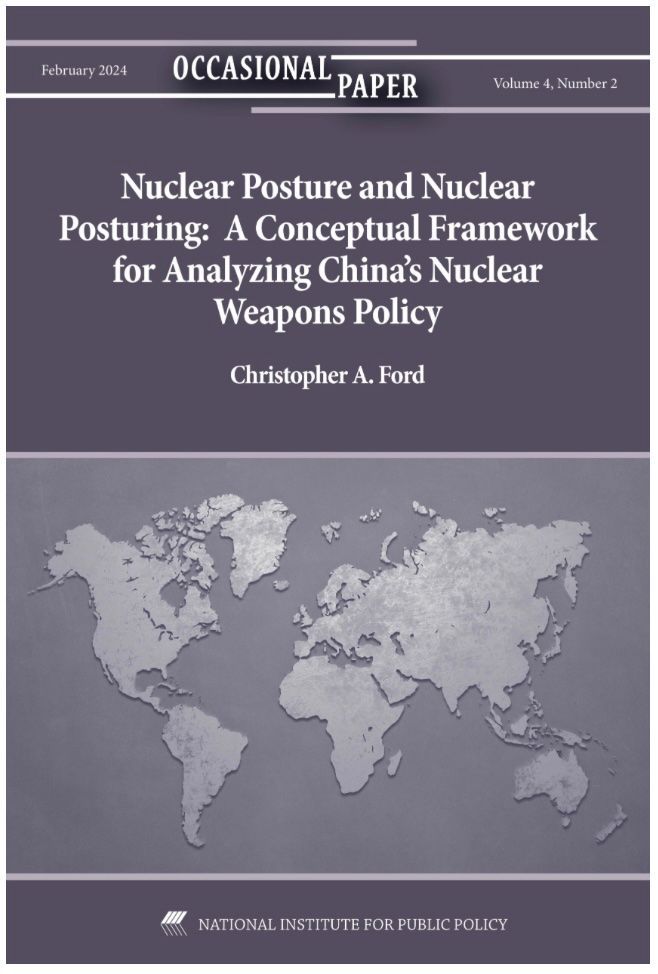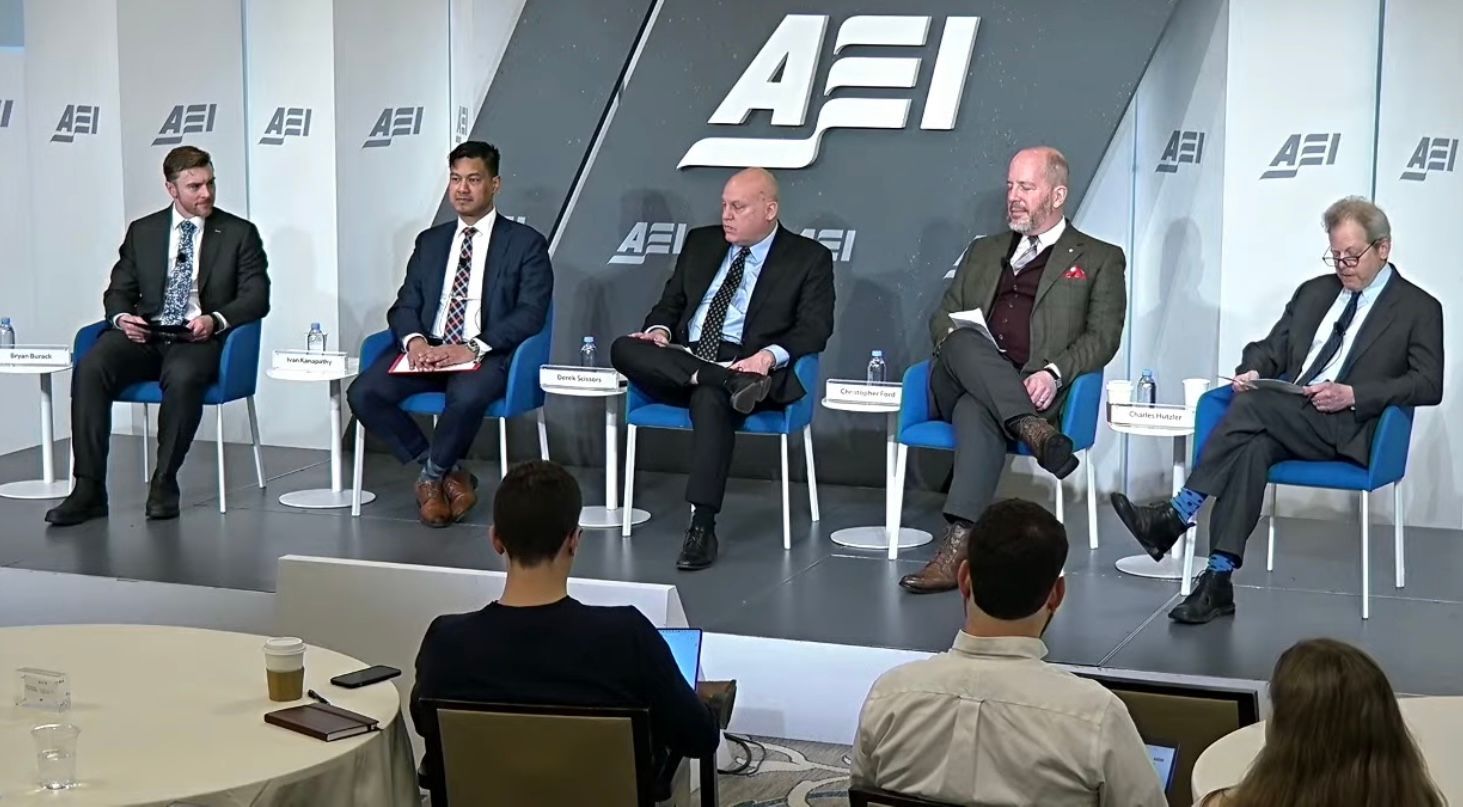The Hon. Christopher A. Ford
New Paradigms Forum -- International Security Policy Since 2009
Prospects and Challenges for East-West Cooperation on Arms Control, Nonproliferation, and Disarmament
Note:
These remarks were presented at a conference sponsored by the Aspen Institute for Contemporary German Studies, Washington, D.C. (June 10, 2009). This conference preceded the establishment of the New Paradigms Forum website, but it has been posted retroactively.
The last time a new U.S. administration took office, the prospects for further East-West cooperation on matters of arms control, nonproliferation, and disarmament looked quite promising. They are said to be promising again, but the intervening years should perhaps teach us some lessons. Improved cooperation may indeed be in the offing between Washington and Moscow, but we should not oversell the degree to which we are likely to see a sea change in the relationship.
I. A Look Back in Time
In 2001, Presidents George W. Bush and Vladimir Putin were both new in office, and they seem initially to have gotten along almost surreally well. (Remember how Bush claimed of Putin to have “looked into his eyes” to see “his soul”?) Moscow was hardly delighted at the quick U.S. decision to withdraw from the Anti-Ballistic Missile (ABM) Treaty, but while it was unhappy it was also in no way surprised. Nor did this prevent the two presidents from quickly reaching a new strategic arms control agreement, the Moscow Treaty, in 2002 – the first ever actually to address nuclear warheads, setting sharply-reduced ceilings that both countries are well on their way to meeting in time for the treaty’s deadline of 2012.
Each country perceived itself to have an interest in continuing the reductions they had begun pursuant to the Strategic Arms Reduction Treaty (START), which had been signed by President Bush’s father in 1991, and its implementation continued apace. To some extent, unilateral reductions also proceeded rapidly – particularly in the United States, which over the next few years removed considerable quantities of fissile material from weapons stocks, accelerated the pace of its warhead dismantlement work, and chose to eliminate delivery systems such as the Advanced Cruise Missile. The United States continued, moreover, to purchase for use in U.S. civilian nuclear reactors uranium down-blended from Russian nuclear weapons programs.
Cooperation on nonproliferation was perhaps the weakest link, but even here one shouldn’t overplay the problems that confronted the Bush-Putin relationship. Russia was deeply enmeshed in nuclear energy cooperation with Iran, but before August 2002, Tehran’s secret nuclear efforts had not yet publicly been revealed and come to dominate the nonproliferation diplomatic landscape. Libya, too, pursued its nuclear weapons program in secret, while the sprawling nuclear smuggling effort run by Pakistani nuclear weapons scientist A.Q. Khan operated in happy and profitable obscurity. In North Korea, even the Americans had been pretending for some years that proliferation had been brought under control by the 1994 Agreed Framework. Storms were brewing on all fronts, but to the public eye the turn of the century seemed to present an encouraging picture for East-West nonproliferation cooperation.
In fact, the iconic nonproliferation push of the 1990s had not focused upon rolling back weapons development programs being pursued in the post-Cold War environment by troublesome regimes such as Iran. Instead, through the Cooperative Threat Reduction (CTR) program, it had emphasized securing fissile material stocks in the corrupt and dysfunctional polities of the Former Soviet Union (FSU). Through a historically unique confluence of circumstances involving Russia’s impoverishment, infrastructural decrepitude, and fleeting interest in opening politically to the West, the two powers found both common cause in securing fissile materials in the FSU and common agreement that the U.S. taxpayer should bear its burdens. With the proliferation rollback challenges of the 2000s then lying mercifully in the future, the U.S.-Russian track record on nonproliferation cooperation seemed to augur well for continued East-West cooperation.
Certainly there seemed little prospect, at the time, of a revival of U.S.-Russian strategic rivalry. Given the degree to which the increasingly thuggish, authoritarian, and paranoid government of Putin-era Russia seems subsequently to have become convinced that the United States and its NATO allies presented a grave, nearly Cold War-style threat, it is ironic the degree to which the incoming Bush Administration was un interested in traditional superpower nuclear competition. Instead, officials in Washington – no longer feeling particularly threatened by Russian nuclear weapons now that they were in the hands of an apparently democratic government not bent upon global hegemony, but now catching glimpses of the coming proliferation storms in highly-compartmented intelligence reporting – developed, in the post-9/11 era, an almost monomaniacal focus upon proliferation threats.
Problems lay ahead in this very mismatch between proliferation-focused America and a Kremlin still nursing a dark, zero-sum worldview reminiscent of its ancien regime. For a time, however, the two countries’ political and psychological paths ran conveniently side by side. Such was the optimism about the course of the U.S.-Russian strategic relationship, in fact, that the Moscow Treaty – negotiated in record time – was deemed adequately verifiable without any specific verification mechanisms, in part because strategic planners and intelligence analysts in each country understood that the other would continue nuclear reductions anyway , irrespective of whether a treaty were agreed.
The Americans’ emphatically post-Cold War orientation would provide quite resilient. Despite Russia’s accelerating efforts to modernize its strategic nuclear forces – including the development of new mobile missiles, a new class of ballistic missile submarine, an exotic “hypersonic glide vehicle,” and new nuclear warhead types apparently in part through the use of low-yield nuclear tests in violation of Moscow’s proclaimed moratorium upon such testing – Washington declined to respond in kind.
Such ideas as were mooted by the Bush Administration about developing one or two new nuclear warheads were focused not upon competing with Russia but upon counter-proliferation missions (the “robust nuclear earth penetrator”) and ensuring the reliability of American deterrence in a test ban environment (the “reliable replacement warhead”). Even these plans were eventually abandoned. Similarly, plans were developed for converting a handful of ballistic missiles to deliver non-nuclear payloads, but only for the purpose of rapidly hitting fleeting targets such as high-level terrorist meetings half a world away – meetings such as the brief al-Qa’ida convocation in Afghanistan that U.S. submarine-launched cruise missiles had just missed incinerating back in 1998.
All in all, it is striking the degree to which the U.S. side has for years regarded the Russo-American nuclear balance as not being particularly relevant to America’s national security and global strategy. Washington, in other words, seemed to have moved on.
II. Problems Emerge
This is not the place to try to analyze in detail precisely what went wrong and why the East-West political atmosphere subsequently soured so much. In part, Russia’s slide back into authoritarianism – and a peevishly irascible nostalgia for the Kremlin’s days of Soviet geopolitical stature – simply made Moscow a much more challenging diplomatic partner for all foreign governments, the United States not excepted. In part, with regard to proliferation, circumstances forced the two powers to grapple increasingly with issues such as the North Korean and Iranian nuclear challenges – where the perceived strategic interests of Washington and Moscow diverged more than had been the case with the nonproliferation agenda of the CTR-focused 1990s.
In part, however, some of the recent problems of East-West relations may ironically be found in the degree to which the strategic relationship between the nuclear superpowers turned into something of a “dialogue of the deaf.” For their part, the Americans were determined – and quite grimly so, after 9/11 – to forge ahead into a 21 st Century world of confronting proliferation threats, a world in which Moscow’s nuclear posture was not very threatening and thus of comparatively little concern. In the Kremlin, on the other hand, Russian minds still resonated with Cold War strategic concepts never quite abandoned, while the regime’s prevailing political pathologies inclined it to see encircling foreign adversaries under every bed, and the siloviki state’s insecure and embittered sense of lost Soviet glory essentially ruled out acceptance of the ironic truth that the American adversary wasn’t really thinking much about Russia at all anymore.
In a sense, perhaps, it was unfortunately all too “perfect” a storm. The Americans accelerated the development of missile defenses aimed at countering evolving threats from North Korea and Iran. As it happened, U.S. efforts included plans to place a missile tracking radar as close to Iran’s northern border as possible, as well as ground-based interceptor missiles early along the trajectory future Iranian missiles – including longer-range sold-fueled varieties already in development – would take on their way to NATO targets in Europe or to North America. Unfortunately, from the perspective of East-West relations, both locations were in the former Soviet fiefdoms of Eastern Europe, in countries (the Czech Republic and Poland, respective) that had subsequently become enthusiastic members of NATO. As the Russians themselves seemed to recognize – in large part presumably on the basis of their experience for some decades as the only country on earth to deploy strategic missile defenses – these U.S. missile defense plans presented no actual threat to Russia’s vastly larger and still distantly located strategic nuclear forces. Nevertheless, they had tremendous political symbolism and a profound psychological impact upon Russia’s brittle geopolitical self-image, evoking rhetorical fury from Kremlin officials whose representatives had earlier told Bush Administration officials that the European deployments would present no problem as long as Russia were not “surprised.”
The Americans also strove to continue the NATO expansion process, both geographically and functionally, still trying – as Washington had been doing since the Clinton Administration – to make of it a global power projection force for humanitarian intervention, counter-terrorism, and nation-building, while opening its doors to more members drawn from territories formerly within the Soviet Empire. After 9/11, the Atlantic Alliance itself became involved in ground combat against Taliban radicals in Afghanistan, which Moscow had once tried to claim as its own and where the Russians had been so famously bloodied by American-armed guerrillas during the 1980s. This, too, while objectively surely no threat to Russia – itself long a bitter adversary to Muslim extremists in Asia’s heartlands – must have sorely tested the sensibilities of Putin-era officials in the Kremlin pining for the empire Moscow had lost.
Most dramatically, perhaps, the United States then invaded another country in the Middle East – a former Soviet client state, no less – in order to suppress what was believed, however erroneously, to be a constellation of weapons of mass destruction (WMD) threats. Iraq perhaps epitomized the conceptual chasm between East and West: a preventative war undertaken on counter-proliferation grounds by an American hyperpower that had no ill intentions toward Russia but whose actions were perhaps inevitably to be deeply resented in Moscow’s corridors of power. The fact that the U.S. Intelligence Community turned out to have gotten their Iraqi WMD analysis so humiliatingly wrong was merely the poisonous icing on an already terribly distasteful cake.
Two political dynamics were perhaps simultaneously in play in this regard. To the extent that the Kremlin accurately perceived that such developments reflected the striking degree to which the Americans were not directing their policies at Russia, nor were even particularly concerned with it, these events were surely galling. The modern Kremlin, insistent upon preserving the trappings of superpower status and keen to re-assert itself in the territories of what it calls – with sometimes shocking neo-imperial candor – its “near-abroad,” does not seem to mind vilification, but simple irrelevance was too much to bear. To the extent, on the other hand, that American policies were interpreted through the gloomy zero-sum spectacles of the Putin regime’s old school geopolitical weltanschauung , they could be seen as corroborating the worst sort of siloviki conspiracy theory. Either way, however, the stage was set for a much chillier sort of post-Cold War Russo-American relationship.
III. “Reset” to What?
Today, there is much enthusiasm for pressing what Vice President Biden described as “the reset button” on the U.S.-Russian relationship. It is far from clear, however, what this actually means, or how much “resetting” is actually possible. The Obama Administration believes that it can turn Russian relations around by not being George Bush, even if actual U.S. policies do not change too very much. Given the Bush Administration’s notable disinterest in diplomatic atmospherics when perceived national security imperatives were on the line in the fight against terrorists and WMD proliferation – an approach bespeaking a fierce earnestness and moral fortitude, but which may not always have served the country well – a deliberate change of tone from the Obama team might have some impact upon the Russo-American political climate.
Nevertheless, the last few years also underscore some deeper problems in the relationship which we should bear in mind as we seek improved cooperation in the months and years ahead. In some areas, the Obama Administration will for a time probably find room for continued cooperation and East-West progress, in much the same way and for similar reasons as did the Bush Administration. Such convergence of interests will have its limits, however, and in some areas may not even be exist at all. Absent a major reconceptualization of national security interests on one or both sides, the much-heralded “reset button” is not likely to produce fundamental changes in the relationship. Congenial atmospherics can be important, but they will only get one so far where core perceptions of national interest diverge in important ways, and political tone is a highly imperfect instrument for effecting change in such basic interest perceptions.
A. Arms Control and Disarmament
Traditional old-style arms control negotiations are one area where there remain grounds for cooperation, at least for a time, since Russia has both political and operational reasons to desire an agreement with Washington for some further force reductions. Operationally, there seems to be room for substantive agreement not merely on some kind of strategic transparency and confidence-building arrangements but indeed also on lower force limits – at least for strategic forces (delivery systems and warheads). The process of reductions from Cold War levels to force postures more appropriate to reduced contemporary threats, which began with START and continued through the Moscow Treaty and unilateral reductions by both sides, but it is not yet complete for either power.
(1) Agreement is Likely
The United States military seems almost shockingly un interested in nuclear delivery missions these days, and possesses an extraordinarily capable suite of non-nuclear military capabilities that seem likely to allow it, as intended, increasingly to deter potential foreign threats without any need of recourse to nuclear explosives. Washington seems easily able to countenance at least some further force reductions, and the United States is perhaps the nuclear weapons state best positioned – with the exception of Britain and France, which ironically have more flexibility precisely because they can rely in part upon America’s nuclear-backed “extended deterrence” – to accept a global nuclear weapons “zero.”
For its part, as noted previously, Russia is firmly committed to modernizing its nuclear forces, deploying new mobile missiles, beginning to build a new class of ballistic missile submarine, and developing new nuclear warhead types. The Kremlin is, however, deploying such new hardware more slowly than it is retiring older Cold War-era systems, with the result that its force levels are likely to continue to shrink all of themselves. Russia seems to believe that while it requires a very different force structure for the 21 st Century, it can also be a smaller one. Moscow, therefore, has no reason not to support – as occurred with the Moscow Treaty – an agreement codifying such reductions.
Precisely because force levels are thus likely to shrink on both sides irrespective of whether they agree to a START successor treaty, it cannot be said that post-START force limits between the United States and Russia are strictly necessary. (It is for this reason that the Bush Administration’s initial approach in the post-START talks begun in September 2006 focused not upon force limits but upon transparency and confidence-building arrangements – that is, upon helping each side understand how strategically threatening the other side isn’t.) By the tame token, however, such force limits are easily possible.
What’s more, both sides presently seem to have strong political incentives to reach such an agreement. After all, President Obama’s much-publicized eagerness to demonstrate “change” in U.S. policymaking would look hollow indeed if he were not able to consummate the post-START talks his predecessor began three years earlier. What’s more, Obama’s most significant political constituencies and his advisors on such matters all hail from a portion of the policy community that stands in almost religious awe of legally-binding force limits as a way to handle international security challenges.
For Russia, there would also seem to exist powerful political incentives to reach a START successor treaty. From Moscow’s perspective, strategic arms control agreements seem to have become the symbolic currency of Russia’s continued superpower status, providing a partial political antidote to discomfiting suspicions of the country’s vastly reduced significance in post-Cold War American security planning. After all, no one else but Moscow enters into such a relationship of formal equality and reciprocity with the U.S. hyperpower on matters related to the most powerful weapons mankind has ever devised.
This may be why Moscow insisted in its discussions with the Bush Administration first and foremost upon having START be succeeded by a legally-binding formal treaty , rather than focusing upon any particular substantive issue that might actually be provided for in such an instrument. The details, apparently, were secondary: what was critical was that Russia still be recognized, implicitly, as “the other superpower” by virtue of having a unique and legally-sanctified strategic nuclear relationship with Washington. Particularly because weapons numbers on both sides are likely to shrink anyway, Moscow thus probably needs arms control rather more than the Americans do – though the Obama Administration’s eagerness to use strategic arms control as an ideological deliverable, demonstrating its arms control and disarmament bona fides , has somewhat evened the score in recent months.
At any rate, agreement is very likely on lower numerical arsenal levels, which ought to satisfy the political objectives of both sides without running seriously afoul of the security interests of either. Moscow would get a renewed treaty and an arms control relationship with the Americans that looks sufficiently like the old days to command respect, while Washington would be able to claim progress toward “zero” and assert vindication of the ideal of capability-limiting arms control as a supposed answer to security dilemmas and strategic instability. Substantively, therefore, no one would “lose,” while politically, both sides would “win.”
(2) Up to a point …
Such common ground, however, is limited, for both sides’ happy willingness to reduce numbers further probably masks some more fundamental divergences on basic questions of the role of nuclear weapons in national security strategy. The United States might be interested in keeping post-START reductions going, until not just low but very low levels are ultimately reached. Conceivably, if such an outcome were thought feasible, verifiable, and sustainable, Washington might in fact at some point embrace “zero.” This, however, is likely to prove anathema to Russia. While there seems to exist a coincidence of interest in somewhat lower force levels, the two countries’ paths seem likely to diverge starkly beyond that point – especially to the extent that arms talks will necessarily have to grapple at some point with the issue of Russia’s extensive collection of “non-strategic” (a.k.a. “tactical”) nuclear weaponry, for which reductions may prove more challenging than for longer-range systems.
Simply put, the principal problem is that Russia appears as attached to its weapons as ever. Perceiving itself unable to defend its territory against sinister foreign encirclements by conventional means, Russia has failed to implement its own Presidential Nuclear Initiatives and hordes so-called “tactical” nuclear weapons by the thousands. It is working hard to modernize its strategic forces, with new delivery systems and new warheads, and is “apparently” playing somewhat fast and loose with its own declared policy moratorium on underground nuclear testing. Russia’s military doctrine emphasizes nuclear warfighting, and even crisis “de-escalation” through the employment of limited nuclear strikes or “demonstrative” detonations. It is not merely that nuclear weapons underpin Russia’s self image as a continued superpower; they are in fact perceived to be essential to concrete challenges facing Russia’s military planning. Even if Russia did perceive itself able to handle current security challenges without nuclear weapons, however, it would still have a political incentive not to eliminate the remaining currency of its residual “superpower” status. All in all, this is not a government likely to be remotely interested in zero.
The issue of ballistic missile defense complicates matters still further, for Russia’s own strategic – and uncomfortably nuclear-weapon-tipped – anti-ballistic missile system is quite long in the tooth and presumably vastly less capable than the new approaches being pursued by the Americans. As long as serious missile defense is asymmetrically possessed – at least until defense-evading technology like Moscow’s new “hypersonic glide vehicle” is fully deployed – Russians will probably perceive additional strong reasons not to let their overall numbers get too low. Since the Kremlin’s allergy to U.S. missile defenses in Eastern Europe seems to be more political and psychological than based upon real capability assessments – and because even the Russians surely feel some discomfiture at the prospect of a nuclear-armed Iran – there may remain some scope for cooperative missile defense work between Washington and Moscow. Nevertheless, Russia is unlikely to view defenses as doing anything but complicating the process of reductions.
(The issue of missile defense in Europe has become doubly complicated, insofar as Russia is well positioned to take advantage of any U.S. reversal on the Eastern European deployments as demonstrating the fickle and undependable character of American alliance ties in the face of Russian political browbeating. Given modern Russia’s volatile combination of insecurity and ambitiousness vis-à-vis the territories of the old Soviet empire, creating an impression of U.S. unreliability by getting Washington to back down on military commitments to new NATO members among the countries of the former Warsaw Pact might powerfully advance the Kremlin’s hopes of reasserting itself as a quasi-hegemon in the region.)
For the reasons suggested previously, however, Russia is unlikely to accept extremely low force totals whether or not the United States continues to pursue missile defense. And for its part – faced with all too obvious proliferation-related threats from accelerating missile-development programs in Iran, North Korea, and perhaps elsewhere – the United States is not likely to abandon such endeavors anyway. Russia will do what it can to persuade the Americans at every turn to purchase increments of formalized arms reduction with the currency of cutbacks in missile defenses. Because this would make Russo-American arms control the enemy of U.S. proliferation preparedness, however –and because U.S. and Russian numbers are likely to shrink regardless of whether an additional arms agreement is reached, making missile defense concessions particularly costly on account of their arguable needlessness – there will presumably be sharp limits upon how much bargaining Washington will be willing to stomach.
In sum, while there is today a useful mutuality of interest between the United States and Russia in a reinvigorated arms control process and further reductions in nuclear weapons stockpiles, this common ground will at some point disappear. It is easy to predict numbers coming down to perhaps significantly lower levels. It is far more difficult to imagine them getting to very low levels, let alone “zero,” without a fundamental reassessment of nuclear strategy by the Russians. Even the Americans, moreover, might easily come to have second thoughts when faced with the prospect of reducing down into a world of multi-player “near-peer” deterrent relationships in which handfuls of foreign powers of various political complexions exist in relationships of at least a numerical strategic parity with the United States. For reasons both political and concrete, strategic nuclear equality with a scrum of regional powers may be difficult for a superpower with global interests to accept. Today’s happy mutuality of Russo-American interest in arms reductions is likely to evaporate well before the point of nuclear abolition.
B. Nonproliferation vis-à-vis State Actors
While it is thus possible to be optimistic, in the short run – though really only in the short run – about the prospects for East-West common ground in strategic arms control, it is an open question how deep and sustained the cooperation can be on nonproliferation. It is not clear that Moscow actually shares anything like the U.S. commitment to nonproliferation when it comes to preventing troublesome regimes in troubled regions of the world from acquiring nuclear weapons or at least a nuclear weapons “option.” At the very least it lacks the American prioritization of nonproliferation. More worryingly, however, it sometimes seems as if Russia is tempted to condone proliferation to actors whose geopolitical impact disproportionately constrains the global strategy and limits the options of Moscow’s perceived great power rival, the United States.
It must indeed be admitted that the geopolitical impact of proliferation in regions such as the Middle East is asymmetric: there is surely some threat to Russia from nuclear weapons in the hands of Iranian clerics or North Korean dynasts, but these regimes do not seek such capabilities in order to deter Russia from intervention or to threaten Russia’s allies with nuclear extortion or even extinction. To be sure, it is difficult to imagine that Russia too much likes the idea, for instance, of a nuclear-armed Iran. Nonetheless, it certainly seems that Russia minds the idea far less than do officials in Washington, and that the Kremlin at least appreciates the degree to which Iran’s march towards nuclear weapons capability disproportionately preoccupies and confounds U.S. policy. A carefully lukewarm approach to preventing state actor nuclear weapons proliferation, in other words, may be quite useful to Russia as an asymmetric strategy to improving Moscow’s relative strategic position vis-à-vis Washington.
It may not be entirely a coincidence, for example, that Russia has protected Iran from tougher U.N. sanctions, has had nuclear cooperation work underway with Iran for many years – including, at least for a while, assistance not jus with the light water reactor at Bushehr but with a reactor at Arak that is transparently designed for plutonium production. In fact, Moscow is apparently even providing Tehran missiles with which to defend the very nuclear sites at which work continues today in defiance of U.N. Security Council resolutions for which Russia itself voted. This is not the hallmark of a power particularly concerned with enforcing nonproliferation norms, at least not where such norms conflict with the priority the Kremlin seems to put upon encouraging the creation of impediments to U.S. power-projection, and perhaps seeing Washington deterred out of a longstanding activist role in the Middle East that officials in Moscow have resented since Cold War days.
All of this means that one should not hold one’s breath for Russia’s sudden conversion to nonproliferation seriousness in the sense that this is understood in Washington, at least not when it comes to state actors such as Iran. It will likely be possible to cooperate on some important topics, but the scope of such cooperation may be more limited than the optimistic pronouncements of the Obama Administration might lead one to believe. There is a school of thought in some American policy circles holding that Russia “gets it” with regard to the threat presented by Iran. Moscow, such thinking has it, is “just as concerned as we are,” and the two powers merely have a gentlemen’s disagreement over remedial tactics. There are, however, grounds to be skeptical of such rosy assumptions.
At the very least, we should not be surprised to find almost any Russian nonproliferation cooperation to be highly transactional. American officials, in other words, may be able to get it, but such cooperation will have a price, and their counterparts in Moscow will try to drive a hard bargain because they have reason to believe that Washington cares more about nonproliferation than they do. By the same token, such transactional cynicism may work the other way as well: America may be out-bid on occasion by those who want to proliferate, should such rogue regimes make Russia the higher offer.
C. Non-State Actor and Nuclear Security
Such warnings, however, do not mean that there is no room for “deep” and sincere cooperation on some matters where perceived Russian and American interests run much more closely in genuine alignment. In the short run, as we have seen, there is probably such a coincidence of interest in strategic force reductions. Another area, however, may concern nuclear weapons and material security – and, in particular, preventing nuclear proliferation to non-state actors such as terrorists.
Nuclear security and preventing terrorist access to nuclear weapons has been a fairly fertile area for East-West cooperation in the past, and is likely remain so for many years to come. The Obama Administration has very ambitious plans in the nuclear security realm – perhaps unrealistically so, since it seems highly unlikely that it will be possible to “secure all vulnerable nuclear material around the world within four years” as the President promised in his April 2009 speech in Prague. If his agenda can survive the collapse of such over-promising, however, there seems no reason why Russia could not become a real partner in nuclear security efforts undertaken on a global scale.
Moscow would presumably prefer to continue to be, as in the past, the passive recipient of U.S. taxpayer largesse in undertaking only regional nuclear security work. Nevertheless, this is not the mid-1990s, and American nuclear security handouts to the petrodollar-fueled Russian economy are likely to diminish whether or not cooperation blooms in other fields. Since both powers would seem to have both real and perceived interests in preventing the acquisition of nuclear weaponry by radical Islamist terrorists, for instance, the United States and Russia would seem well positioned to take advantage of a genuine coincidence of interest and reasonably compatible senses of its prioritization.
-- Christopher Ford



Copyright Dr. Christopher Ford All Rights Reserved






